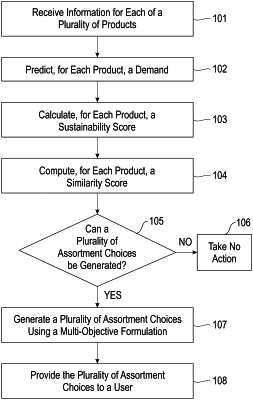| CPC G06Q 10/06315 (2013.01) [G06N 3/04 (2013.01); G06N 3/08 (2013.01); G06Q 10/087 (2013.01); G06Q 30/0202 (2013.01)] | 18 Claims |

|
1. A method, comprising:
receiving, at a product prediction computing device, information for each of a plurality of products for possible sale at a retail store of a plurality of retail stores;
for each of the plurality of products:
predicting, using a deep-learning model unique to the retail store by being trained utilizing information of the retail store, a demand for a given product of the plurality of products when included within the retail store for sale and unique to the retail store by determining whether the given product of the plurality of products has historical sales information, wherein the deep-learning model predicts demand for products having historical sales information and also for products having no historical sales information, wherein the deep-learning model is trained based upon attributes of the products having historical sales information, historical sales data of the products having historical sales information, and the information of the retail store for which the deep-learning model is trained, wherein the deep-learning model learns correlations between the attributes of the products having historical sales information and the historical sales data of the products having historical sales information to predict the demand for the given product of the plurality of products within the retail store based upon attributes of the given product of the plurality of products, wherein the deep-learning model is retrained based upon the historical sales data of the products having historical sales information in view of previous predictions of the deep-learning model, wherein each retail store of the plurality of retail stores has a unique associated deep-learning model trained for a given retail store;
calculating, using the product prediction computing device, a sustainability score, wherein the sustainability score is based upon a material composition of the given product of the plurality of products;
and computing, using the product prediction computing device, a similarity score by performing a pair-wise similarity calculation comprising comparing pairs of products within the plurality of products, wherein one of the products within each of the pairs is the given product of the plurality of products, wherein the similarity score for the given product of the plurality of products comprises performing the pair-wise similarity calculation for the given product of the plurality of products against each other product of the plurality of products, wherein the similarity score for the given product of the plurality of products comprises a plurality of similarity scores, each corresponding to one of the pair-wise similarity calculations including the given product of the plurality of products;
generating, using the product prediction computing device and utilizing a multi-objective formulation, a plurality of assortment choices from the plurality of products, wherein each of the plurality of assortment choices comprises a subset of the plurality of products and has a corresponding assortment demand value computed using the multi-objective formulation from the predicted demand for each of the plurality of products within a given assortment choice of the plurality of assortment choices, assortment sustainability score computed using the multi-objective formulation from the calculated sustainability score for each of the plurality of products within the given assortment choice of the plurality of assortment choices, and assortment similarity score computed using the multi-objective formulation from the computed similarity score for each of the plurality of products within the given assortment choice of the plurality of assortment choices;
and providing, using the product prediction computing device, the plurality of assortment choices to a user for selection of one of the plurality of assortment choices to be included within the retail store for sale.
|